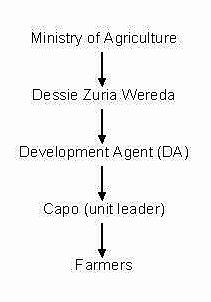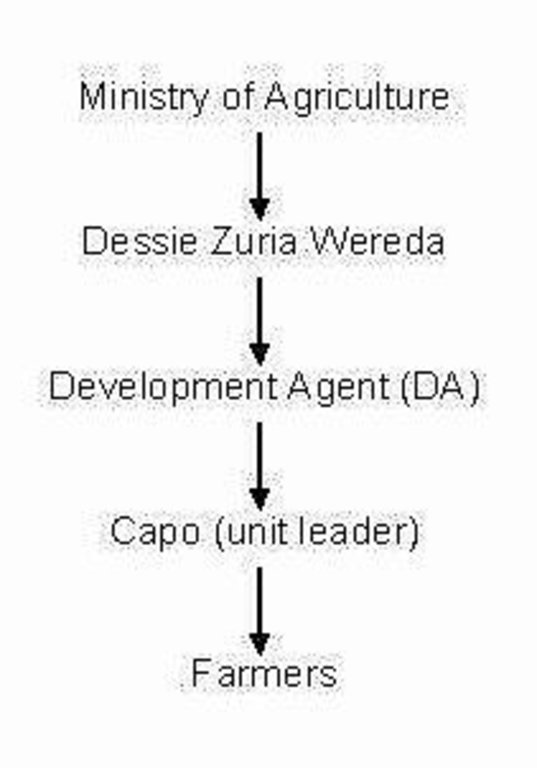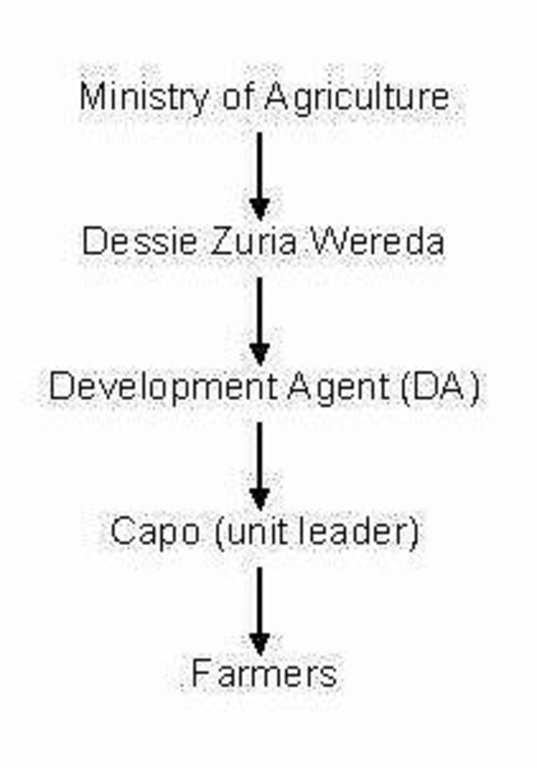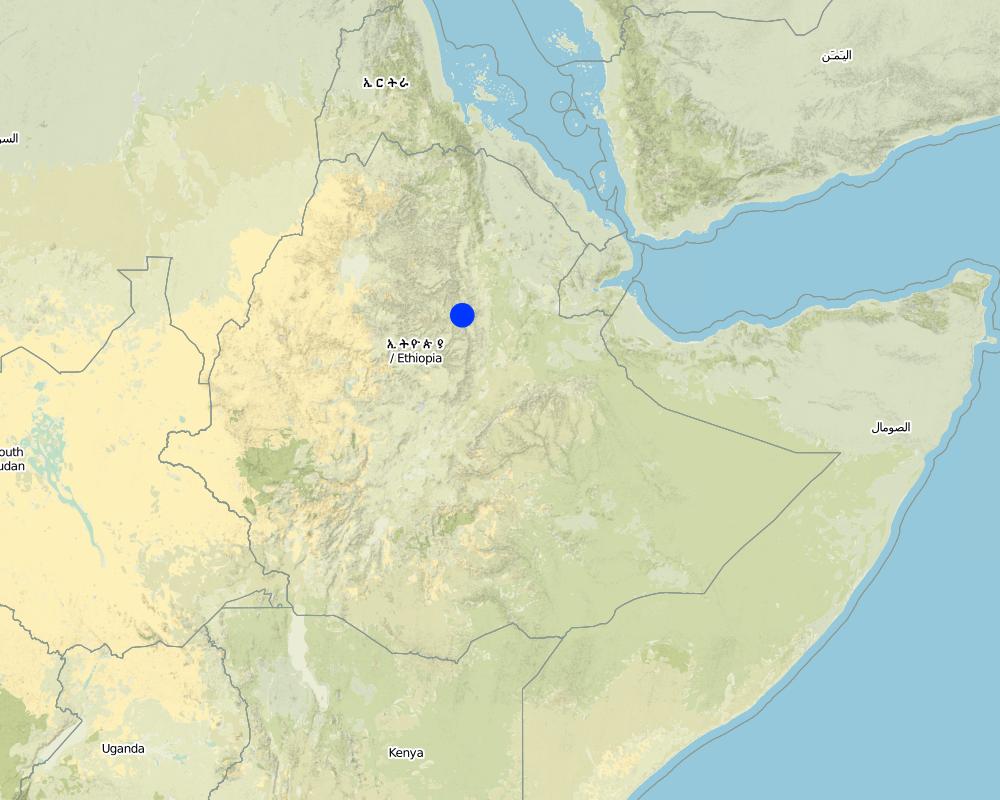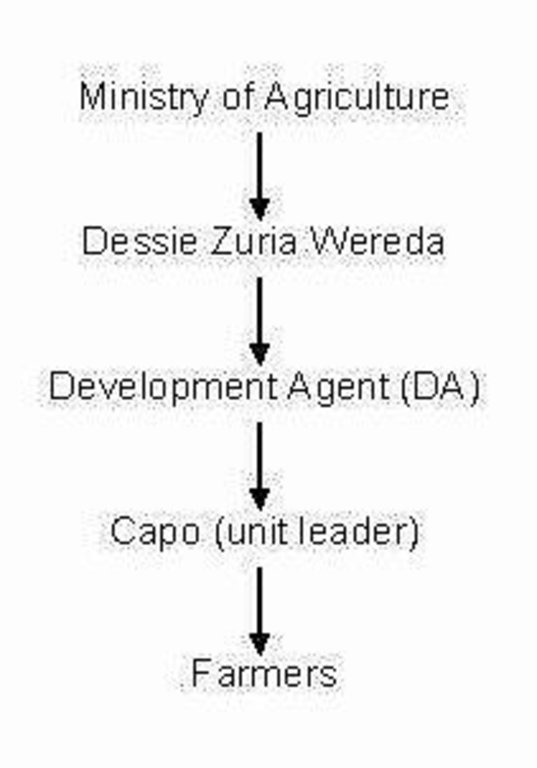food-for-work programm [埃塞俄比亚]
- 创建:
- 更新:
- 编制者: Sabina Erny
- 编辑者: –
- 审查者: Fabian Ottiger
approaches_2554 - 埃塞俄比亚
查看章节
全部展开 全部收起1. 一般信息
1.2 参与方法评估和文件编制的资源人员和机构的联系方式
1.3 关于使用通过WOCAT记录的数据的条件
编制者和关键资源人员接受有关使用通过WOCAT记录数据的条件。:
是
1.4 SLM技术问卷的参考
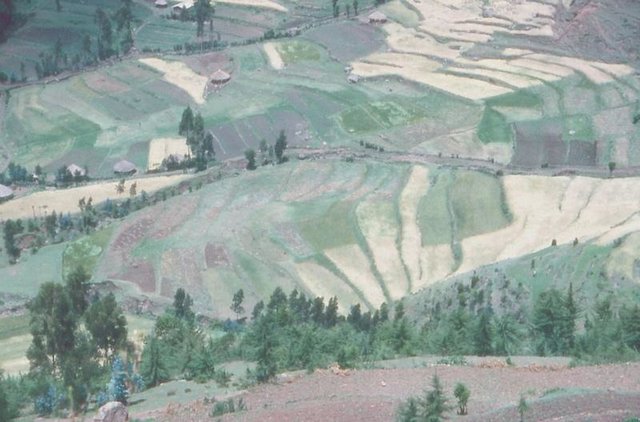
level bund with double stone walls [埃塞俄比亚]
level bund with double stone walls with soil and grass to stabilize the structure
- 编制者: Sabina Erny
2. SLM方法的描述
2.1 该方法的简要说明
food-for-work programm with distribution of grains and oil
2.2 该方法的详细说明
该方法的详细说明:
Aims / objectives: Overall purpose: contribute to the SWC of the area; Specific objectives: build the level bunds, reforestation and the cut-off drains
Methods: Incentives for work
Stages of implementation: Collect farmers, tell them about the conservation, they formed groups/units who worked under a unit leader (capo=chief)
Role of stakeholders: Farmers carried out the work, the construction of the level bunds, the planting of trees. The technician told them what to do. Passive role of the farmers.
Other important information: Discussion started after implementation when farmers came to eht research station to get advice what they could do about the narrow terraces on the steep steep slopes and against the rats. Together they found a solution.
2.3 该方法的照片
2.5 采用该方法的国家/地区/地点
国家:
埃塞俄比亚
区域/州/省:
South Wello
Map
×2.6 该方法的开始和终止日期
注明开始年份:
1983
终止年份(若不再采用该方法):
1985
2.7 方法的类型
- 基于项目/方案
2.8 该方法的主要目的/目标
The Approach focused mainly on SLM with other activities (1984 construction of water channel for water pump for an irrigation project (outside of described catchment, but affectsuing people within catchment as well), road from main road Dessie-Jemme-Borana down to lake was constructed through the same approach)
give food and get work for it; not just getting the food even though there was a drought, but the people received only food if they worked for it
The SLM Approach addressed the following problems: drought, to improve the field qualities, prevention of erosion, to give the hungry farmers food because they were suffering from shortage of food
2.9 推动或妨碍实施本办法所适用的技术的条件
社会/文化/宗教规范和价值观
- 阻碍
farmers were weak because of drought
Treatment through the SLM Approach: food helped because they got it every 2 weeks
财务资源和服务的可用性/可得性
- 阻碍
time-consuming activities
Treatment through the SLM Approach: food-for-work
法律框架(土地使用权、土地和水使用权)
- 启动
The existing land ownership, land use rights / water rights helped a little the approach implementation
了解SLM,获得技术支持
- 阻碍
not enough material
Treatment through the SLM Approach: shovel, hoes lend to the farmers
3. 相关利益相关者的参与和角色
3.1 该方法涉及的利益相关者及其职责
- 当地土地使用者/当地社区
Working land users were mainly men (also some women)
The capo is a man; it is the culture and tradition that men work on the field, women collect stones; men dig lines, bring soil with the shovel, build stone walls
- 国家政府(规划者、决策者)
- 国际组织
如果涉及多个利益相关者,请注明领导机构:
Designed by SIDA
3.2 当地土地使用者/当地社区参与该方法的不同阶段
| 当地土地使用者/当地社区的参与 | 指定参与人员并描述活动 | |
|---|---|---|
| 启动/动机 | 无 | |
| 计划 | 被动 | information |
| 实施 | 外部支持 | Mainly: casual labour; partly: responsibility for major steps; the capo has a greater responsibility |
| 监测/评估 | 无 | |
| Research | 被动 | on-station |
3.3 流程图(如可用)
3.4 有关SLM技术选择的决策
具体说明谁有权决定选择要实施的技术:
- 仅限SLM专家
解释:
Decisions on the method of implementing the SLM Technology were made by by SLM specialists alone (top-down)
4. 技术支持、能力建设和知识管理
4.1 能力建设/培训
是否为土地使用者/其他利益相关者提供培训?:
是
明确受训人员:
- 土地使用者
- SWC specialists
培训形式:
- 示范区域
- 公开会议
涵盖的主题:
the cattle should not enter the cultivated land until bund is established; how to maintain the bunds was also demonstrated
4.2 咨询服务
土地使用者有权使用咨询服务吗?:
是
指明是否提供了咨询服务:
- 在固定中心
说明/注释:
1) Advisory service was carried out through: projects own extension structure and agents; Extension staff: mainly government employees 2) Target groups for extension: land users
Advisory service is inadequate to ensure the continuation of land conservation activities; they need new, different technologies, another training to give to the people
4.3 机构强化(组织发展)
是否通过这种方法建立或加强了机构?:
- 否
4.4 监测和评估
监测和评估是该方法的一部分吗?:
是
注释:
technical aspects were ad hoc monitored through observations
There were no changes in the Approach as a result of monitoring and evaluation
4.5 研究
研究是该方法的一部分吗?
是
明确话题:
- 社会学
- 生态学
提供进一步的细节,并指出是谁做的研究:
it was especially undertaken for the environment
Research was carried out on station
5. 融资和外部物质支持
5.1 该方法中SLM组成部分的年度预算
注释(例如主要的资助来源/主要捐助者):
Approach costs were met by the following donors: international non-government (WFP): 100.0%
5.2 为土地使用者提供财政/物质支援
土地使用者是否获得实施该技术的财政/物质支持?:
是
5.3 对特定投入的补贴(包括劳动力)
- 设备
| 具体说明哪些投入得到了补贴 | 程度如何 | 对补贴做出具体说明 |
|---|---|---|
| 工具 | 部分融资 | Hand tools |
如果土地使用者的劳动力是一项重要的投入,那么是不是:
- 以粮换工
注释:
grains and oil
5.4 信用
是否根据SLM活动的方法给予信用值?:
否
6. 影响分析和结论性陈述
6.1 方法的影响
该方法是否帮助土地使用者实施和维护SLM技术?:
- 否
- 是,很少
- 是,中等
- 是,支持力度很大
terraces
Did other land users / projects adopt the Approach?
- 否
- 是,很少
- 是,中等
- 是,支持力度很大
6.3 方法活动的可持续性
土地使用者能否维持通过该方法实施的措施(无外部支持的情况下)?:
- 不确定
若否或不确定,请具体说明并予以注释:
only some of them can because it needs lots of labor and time
6.4 该方法的长处/优点
| 土地使用者眼中的长处/优势/机会 |
|---|
| incentives are good to start the project (How to sustain/ enhance this strength: give food, material) |
| they learned a lot from the project (How to sustain/ enhance this strength: give them more information, train them) |
| they were happy to get some food |
| 编制者或其他关键资源人员认为的长处/优势/机会 |
|---|
| pass on information, trainings (How to sustain/ enhance this strength: give more information and trainings) |
6.5 该方法的弱点/缺点以及克服它们的方法
| 土地使用者认为的弱点/缺点/风险 | 如何克服它们? |
|---|---|
| payment was fixed, but because of the drought, the farmers were too weak to work | payment should be flexible |
| top-down | more bottom-up |
| 编制者或其他关键资源人员认为的弱点/缺点/风险 | 如何克服它们? |
|---|---|
| not having asked the farmers; top-down approach | involve farmers from the beginning, so they feel needed and useful |
| local knowledge has not been considered | ask the farmers and integrate their knowledge |
| incentive food should be reconsidered especially because it was not flexible and there was a drought and they strictly distributed it according to their measures and not according to the situation | no strict calulation formula of the food, so there is space to give more food if needed as it would have been the case here since there was a serious drought at the stage of implementation |
7. 参考和链接
7.1 方法/信息来源
- 实地考察、实地调查
- 与土地使用者的访谈
链接和模块
全部展开 全部收起链接

level bund with double stone walls [埃塞俄比亚]
level bund with double stone walls with soil and grass to stabilize the structure
- 编制者: Sabina Erny
模块
无模块


